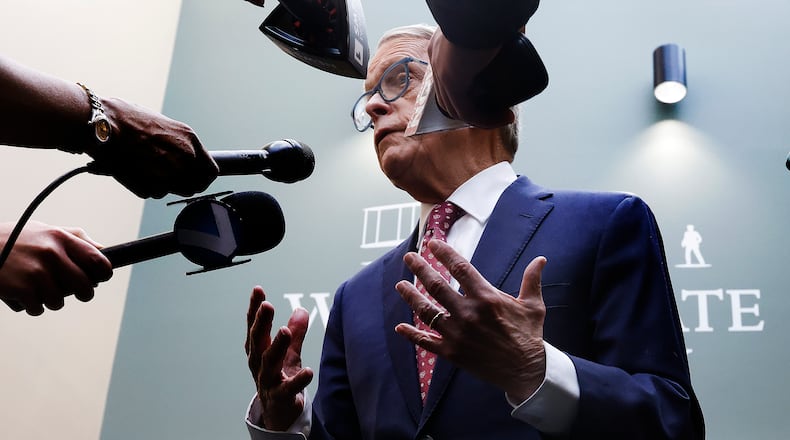- Give Ohio families a $1,000 tax credit per child, funded by a $1.50 cigarette tax increase;
- Increase sports gambling taxes from 20% to 40% and direct the new revenue into a fund for major and minor league teams to improve or fully replace their stadiums and for the state to offset sports costs for Ohio youth;
- Increase recreational cannabis sales tax from 10% to 20%;
- Further tie state funding of public universities to graduates’ career placements;
- Continue Ohio’s universal school choice voucher system and implement the state’s third and final round of its state school funding formula.
The state’s discretionary budget has long been expected to be meeker than the 2024-2025 operating budget, which was buoyed by billions in federal COVID-19 and pandemic recovery spending. Those offsets allowed lawmakers to create a $700 million special projects fund, slash the state’s income and business taxes, create a bigger-than-ever tax holiday, and expand the private school voucher system to nearly a billion dollars a year.
“We should look at this coming budget — this budget — as a budget that goes back to normal,” DeWine told reporters at a Monday press conference. “We had a lot of federal dollars coming in, those federal dollars are not coming in anymore.”
With federal funding added in, DeWine’s proposal comes out to $218 billion over the next two years.
Ohio’s budgetary process is the first big project of every new Ohio General Assembly. The operating budget, sometimes known as the executive budget, is a gargantuan piece of legislation that includes tens of billions in funding for programs and a raft of legislative policies folded in. The process always starts with an initial proposal from the governor’s administration before that proposal is vetted and amended by the Ohio House and Senate, in that order.
Children and K-12 education
DeWine said his proposed budget comes with “increased funding in the K-12 funding formula and school choice programs.”
His proposal asks for the final phase of the state’s so-called fair school funding plan, which has been fervently defended by public school advocates since it was first implemented to get the state’s public school funding less reliant on property taxes. The formula was designed to be implemented over three budgets.
However, slight tweaks were made in the governor’s proposal to reduce “funding guarantees” in the formula, thereby sending less money per student to districts that are losing enrollment.
“This plan includes a phase-in of the final two years of the General Assembly funding plan, and also allows us to phase out the funding of empty desks in schools,” DeWine said.
DeWine’s proposal also continues the state’s universal school choice voucher program, which was implemented in the previous budget and has seen a considerable usage uptick without a matching uptick in private school enrollment.
In terms of new policy, the governor touted a plan to increase health centers on school campuses. He also hopes to couple the state’s existing free eye exam for students program with a state guarantee that students from kindergarten through third grade receive the care they need. DeWine estimated this could affect 33,000 students in Ohio and improve learning outcomes.
“School-aged children in the state of Ohio are required to receive vision screenings, but shockingly, only 26% of the students who need additional vision care, whether that be a comprehensive eye exam or glasses, actually receive it, leaving tens of thousands of our Ohio children behind,” DeWine said. “That is wrong. This budget will start to correct that.”
DeWine, citing the fact that drivers ed has become cost-prohibitive for many Ohio families, included in his proposal a mandate for public schools to begin teaching drivers ed. He said doing so would enhance roadway safety, as many Ohioans wait until they’re a legal adult — and not required to take drivers ed — to get their license.
“Let me say it very clearly: It’s now time to put drivers training back in our high schools. This needs to be done. Schools are the logical and most accessible places for teams to learn how to drive,” DeWine said. “Our budget helps schools partner with independent driving training academies, or allows them to start their own driver training program to make this training affordable for families and bring it directly to the students.”
The budget also creates a $34 million grant program for school districts to implement recommendations of the state’s School Bus Safety Working Group, a commission the governor created following a fatal 2023 Clark County school bus crash.
Additionally, DeWine called for the creation of an income-based child tax credit, which would provide $1,000 in tax refunds per year per child up to age 6, which the governor said could help Ohio families pay for their increasingly expensive rents, mortgages or child care.
DeWine’s plan suggests paying for the credits by raising Ohio’s cigarette tax from its current $1.60 per pack to $3.10.
Higher education
DeWine’s budget also works to create a pipeline to incentivize Ohio students to attend Ohio universities by guaranteeing main campus admission to every state college in Ohio for students who finish in the top 5% of their high school graduating class.
On a similar note, his budget would set up a “direct admission initiative,” which DeWine said would “let high school students know, based on simple criteria such as grade point average, SAT, and ACT scores, the list of Ohio colleges and universities where they will be admitted.”
DeWine said such a program would eliminate the need to apply to various colleges and wait for acceptance. “All they will need to do is simply register and enroll in the college that they choose,” he said.
DeWine’s budget also adds post-grad employment rates to the state’s public university funding formula. The state spends about $2 billion on universities per year; about $100 million of that would be subject to the gainful employment rate of universities’ graduates under DeWine’s proposal.
“(My budget would make) Ohio the first state, we believe, in the nation to tie a significant portion of funding for colleges and universities to whether their graduates are, in fact, getting jobs,” DeWine said.
Other policies
DeWine also baked in a proposed “permanent solution” to Ohio’s recurring headache caused by professional sports teams asking the state to subsidize the renovation or complete replacement of professional facilities, as the Cleveland Browns are currently negotiating.
DeWine’s proposed fix is to create the “sports facilities construction and sports education fund” in the state’s coffers. DeWine’s plan is to raise taxes on sports betting companies from 20% to 40% and direct the newly generated revenue to this fund, which would be administered by an appointed commission.
The revenue could be used for major and minor league facility upgrades, as well as to offset some costs for youth sports for some Ohio children.
DeWine estimates the extra tax would produce $130 million to $180 million per year.
“These sports gaming (companies) are extremely aggressive. Maybe it’s just because I watch sports, but they’re in your face all the time, they are getting Ohioans to lose massive amounts of money every year, and it seems to be only just and fair that some of the stadiums are paid for by them,” said DeWine.
Additionally, DeWine said his proposal would raise taxes on recreational cannabis sales from 10% to 20%. According to state documents, the resulting revenue would be routed toward peace officer training, drug enforcement and safe driver initiatives under the proposal.
For more stories like this, sign up for our Ohio Politics newsletter. It’s free, curated, and delivered straight to your inbox every Thursday evening.
Avery Kreemer can be reached at 614-981-1422, on X, via email, or you can drop him a comment/tip with the survey below.
About the Author

